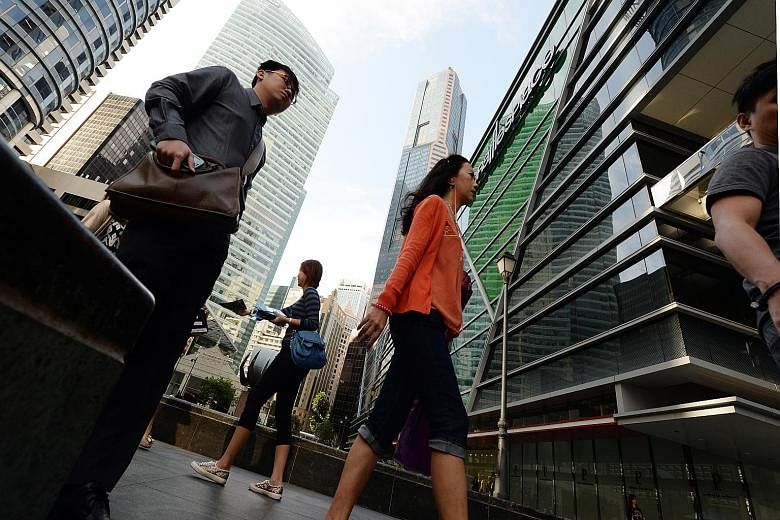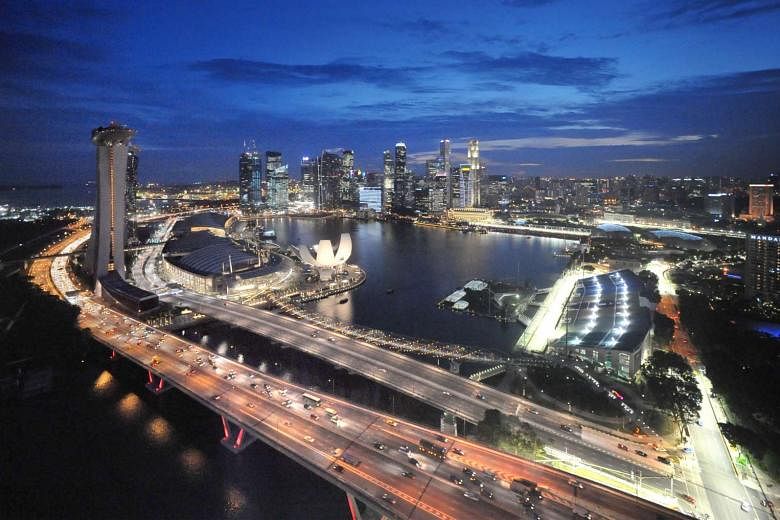It was about five years ago that the world averted financial ruin, saved only by the trillions of dollars pumped in by taxpayers and governments around the world.
The heady days of 2010 saw China overtake Japan as the second- largest economy in the world while the price of crude oil climbed to nearly US$91 a barrel.
Singapore also celebrated in the afterglow of that close shave, with its economy growing 15.2 per cent, the fastest annual rate on record.
It was also in 2010 that the Government endorsed a report that looked at long-term strategies for the Singapore economy and how the country should position itself in the post-financial crisis world.
The Economic Strategies Committee (ESC) had said then that the next 10 years would provide greater opportunities for growth, but would also present greater challenges due to land constraints and slower workforce growth.
It proposed bold ideas to grow the Singapore economy - higher productivity, improved skills and more innovation - strategies it believes will transform the economy, raise living standards and enable Singapore to take full advantage of the opportunities emerging around the world. Today, the picture is completely different, and a lot less optimistic.
China is expected to record below 7 per cent growth, the slowest in six years; a barrel of crude oil can be bought for just US$48; and Singapore could slip into a technical recession this year, with growth forecast at just 2 to 2.5 per cent.
The changed circumstances have prompted some experts to call for a review of the plans made by the committee back in 2010, a suggestion which Prime Minister Lee Hsien Loong indicated the Government was open to considering .
"Every few years we've had an economic review. I did one, probably the first one, 30 years ago back in 1985, and since then we've done one every five to 10 years.
"And maybe it's time for us to take a look again," he said during a dialogue at the Singapore Summit last Saturday.
Is it time to chart a new path? What should be examined or changed? Insight takes a look at some of the key areas that should be reconsidered.
PRODUCTIVITY STAGNANT
Among the many suggestions put forward by the ESC, productivity remains the most contentious issue.
The ESC set a productivity growth target of 2 to 3 per cent annually, a target that the Government has since admitted was an ambitious one.
Despite efforts to boost labour productivity growth, it remains stuck in reverse, with the overall figure in the first half of this year in negative territory, where it has been sitting stubbornly since a year ago. Since 2010, productivity has actually fallen 0.05 per cent a year on average, a DBS report showed.
The Government's response has been on two fronts.
One has been to encourage companies to use better technology and processes to raise their bottom line and get more value from their workers. Policies such as the Productivity and Innovation Credit scheme, which gives tax breaks and cash incentives for moving to more productive technologies, have been rolled out.
The second prong has been to wean companies off cheap sources of labour by tightening the growth of foreign worker numbers here through levies and administrative changes.
While many observers agree that the productivity drive strategy is the right approach to take, they say the authorities have "failed" in its implementation.
For one thing, SMEs are not getting enough attention, says entrepreneur and former MP Inderjit Singh.
"On the surface there are many schemes but I think we are stuck at the surface and not able to get to the root of the issues and are not sufficiently organised to make real fundamental changes, " he adds.
Specifically, SMEs - which account for 70 per cent of employment in Singapore - are now struggling to make ends meet. Costs are rising, potentially offsetting any gains from mechanisation and technology.
The Association of Small and Medium Enterprises (ASME) says policy measures in recent years have helped firms become more efficient, whether it is through mechanisation, redesigning processes or maximising each unit of labour.
"But we are not seeing effective cost management solutions for businesses," says ASME president Kurt Wee. He points out that labour costs have jumped significantly for many smaller firms.
Mr Singh agrees, noting that if nothing is done to review costs, Singapore's competitiveness will be affected: "If we do not make Singapore more conducive for business, especially in cost and labour growth, we will not be able to keep our competitiveness for long."
A recent Singapore Chinese Chamber of Commerce and Industry survey of businesses noted similar concerns.
The poll found that salaries and rentals contribute the most to rising business costs, followed by compliance costs and government administration fees.
One suggestion is for the Government to do a detailed study of business costs alongside any further moves to boost productivity.
Says Mr Wee: "There might be some grounds to warrant a study on how much of the cost is actually policy-triggered, such as compliance cost, levies and so forth."
At the same time, analysts also say that a better way of calculating productivity is required, particularly as the open nature of Singapore's economy means efficiency gains can be distorted by global business cycles.
Currently, productivity is derived by taking the total gross domestic product (GDP) divided by the number of workers, or GDP per worker. But analysts have been calling for different ways of calculating productivity.
"For example, in the construction sector, we can have square metre per man day. In F&B, it could be table turnovers," says DBS economist Irvin Seah.
As Barclays Capital economist Leong Wai Ho puts it: "Is it about doing things better, or doing the right things better?"
PEOPLE POWER
Another key suggestion raised by the ESC was that of managing the economy's dependence on foreign workers.
While skilled foreign manpower will remain valuable to Singapore, there are limits to raising numbers. Easy access to labour would also affect efforts to lift the lot of lower- wage workers.
Five years on, the move by the Government to restrict the flow of foreign workers has been effective. While the number of foreign workers is still rising, growth has slowed significantly. Overall annual foreign workforce growth has moderated from 144,500 in 2007 to 34,000 in 2014.
But some analysts wonder if it is time to revisit the need to restrict certain types of foreign labour.
Mr Seah of DBS says the strategy of tightening over the past four years has been targeted at the wrong places: "The categories that are more in demand, such as construction where you can't find locals to fill up (the vacancies), need to be tightened at a slower pace." He suggests that the flow of workers in jobs that Singaporeans can do, such as managerial or executive positions, be tightened at a faster pace instead.
Another suggestion: Recalibrate measures so that the tightening is specific to each industry and takes into account productivity gains.
Tightening the labour force is not a wrong strategy, says Mr Singh. But he adds: "It's just that we have implemented (it) at the wrong time and at the wrong pace. This needs to be recalibrated along with our goals of productivity targets."
For local workers, the move to keep Singaporeans equipped with new skills to take on future economic challenges is a sound one, economists say.
SkillsFuture, a broad-based national continuous education and training movement with details introduced in this year's Budget, is likely to be a big part of any future economic road map.
A slower foreign worker intake, coupled with an ageing population, means that employers will increasingly have to embrace middle-aged and older workers.
This calls for a rethink of traditional career paths in organisations, creating more flexibility and increasing training to enable this workforce to operate effectively, says consultancy Deloitte Southeast Asia.
Mr Wee of ASME adds: "SkillsFuture is necessary in the long term and in the order of things, because your workforce needs to be able to remain mobile despite economic circumstances."
POLITICS REDEFINED
But any move to restructure the economy will have to be measured against rising expectations of voters.
In dissecting the results of the Sept 11 General Election, which saw the People's Action Party (PAP) win a 69.9 per cent share of the popular vote nationwide, Mr Singh notes that the success of the ruling party was in rectifying many of the problems that surfaced in the 2011 elections.
Among the crucial factors which explain the win, he notes, is the fact that major issues such as transport, housing availability and cost had been addressed. This resulted in many of the swing voters choosing the PAP over the opposition.
Policy-wise, the Government is expected to continue to be consultative, and show its ability to connect with the ground.
For example, any move to reshape the foreign worker policy will have to be tempered by the promise to cap the foreign worker component to a third of the local workforce.
Deputy Prime Minister and Finance Minister Tharman Shanmugaratnam has also indicated that there is much more to be done on the social welfare front.
At a PAP rally for East Coast GRC on Sept 9, during the election campaign, he said: "First, we are rebalancing between economic and social policies. No matter how successful our economy is, success by itself will not give us an inclusive and fair society."
But having garnered a strong mandate in the elections, would the Government now have to tread carefully as it embarks on the next stage of restructuring?
Singapore Management University law professor Eugene Tan believes so.
"Treading carefully is something which will probably be the new mantra. That's necessary in terms of trying to maintain trust. But treading carefully doesn't mean that the Government shouldn't be bold and that society should resist any change."
Policymakers, he adds, should press on with restructuring efforts as they continue to engage various stakeholders.
"What happened in the last four years should give them enough confidence that they are generally on the right track. But it is by no means a done deal," he says.
"They will be even more hard- pressed to engage even better. Now with their hand strengthened, they are a lot more comfortable and they should be able to press on with some of the changes."
The last four years while seemingly difficult, could be the easy part, he says. But this may not be the case in the next four years.
The outcome of the Sept 11 General Election will also have a bearing on the road ahead for the economy, and the country as a whole.
One of the goals PM Lee set was to ensure that the bulk of the fourth-generation leadership team is in place.
That has been achieved.
The confluence of a changed political landscape, challenges and opportunities ahead for the economy, and a new team in place to help shape the direction for Singapore's future, makes it an opportune time for a substantial review of the economy to take place.




